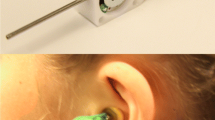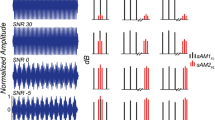Abstract
The auditory function of four wild-caught echidnas was measured using distortion product otoacoustic emissions (DPOAEs) and auditory brainstem responses (ABRs). Emission audiograms were constructed by finding the stimulus levels required to produce a criterion emission amplitude at a given stimulus frequency. For an emission amplitude of -10 dB SPL, the median "best threshold" was 28 dB SPL, and this minimum threshold occurred between 4 and 8 kHz for all animals. The relative effective range of auditory function was defined by the frequencies at which the audiogram was 30 dB above its best threshold. For the emission audiograms, the median lower-frequency limit was 2.3 kHz, the upper limit was 18.4 kHz, and the effective range was 2.7 octaves. The audiogram as measured by ABR was also found to be strongly "U" shaped with similar low- and high-frequency limits, i.e., from 1.6 to 13.9 kHz, with an effective range of 3.1 octaves. These results suggest that the echidna has a behavioral hearing sensitivity comparable to that of typical therian mammals (e.g., rabbits and gerbils) but with a significantly narrower frequency range. DPOAE responses were also measured in selected animals as a function of the variation of all four stimulus parameters (frequencies and intensities of both stimulus tones). Overall, the measured emission responses establish that the echidna does have a cochlear amplifier, and that it could be the same type as in therian mammals. The amplification mechanism in the echidna, currently unidentified, clearly operates to frequencies above 20 kHz, higher than the hearing function observed in any birds or reptiles but lower than for typical therian mammals. This raises the possibility that at least some aspects of the mammalian cochlear amplifier developed early in evolution, before the divergence of the monotremes (echidna and platypus) from the mainstream therian mammals (marsupials and placentals). In this respect, the presence or absence of outer hair cell electromotility in monotremes would have important consequences for understanding the function and evolution of the vertebrate inner ear.
Similar content being viewed by others
Author information
Authors and Affiliations
Rights and permissions
About this article
Cite this article
Mills, D., Shepherd, R. Distortion Product Otoacoustic Emission and Auditory Brainstem Responses in the Echidna (Tachyglossus aculeatus) . JARO 2, 130–146 (2001). https://doi.org/10.1007/s101620010059
Published:
Issue Date:
DOI: https://doi.org/10.1007/s101620010059




